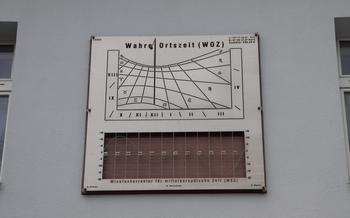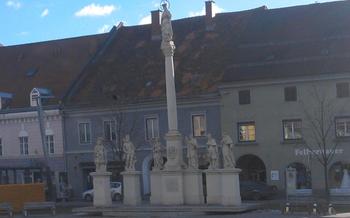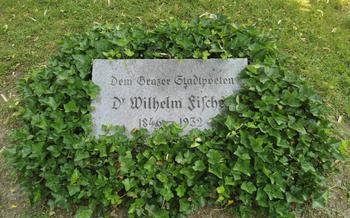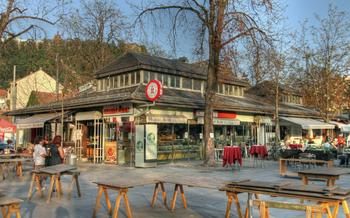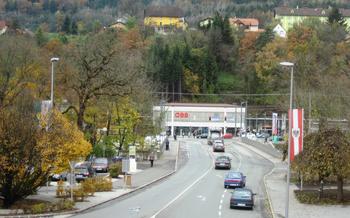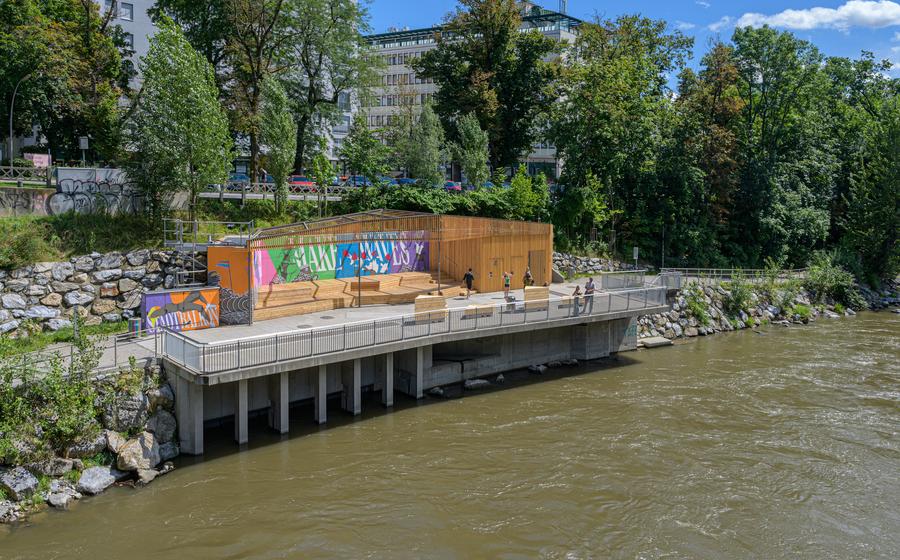
Grazer Bergland (Hiking Area)
- Grazer Bergland: A Hiker's Paradise
- Planning Your Adventure
- Popular Hiking Trails
- Alpine Huts and Accommodation:
- Hiking Safety and Etiquette
- Local Cuisine and Delicacies
- Cultural Highlights and History
- Wildlife and Nature
- Off-the-Beaten-Path Gems:
- Family-Friendly Adventures: Hiking with Kids in the Grazer Bergland
- Solo Hiking and Safety:
- Seasonal Variations
- Local Events and Festivals:
- Insider Tip: Unveiling the Enchanting Kulmspitze Summit
Grazer Bergland: A Hiker's Paradise
In the heart of Austria, nestled amid rolling hills and pristine landscapes, lies the Grazer Bergland, a hiker's paradise waiting to be explored. This enchanting region beckons with its breathtaking natural beauty, diverse trails catering to all levels, and the allure of traditional alpine huts.
The Grazer Bergland boasts a tapestry of landscapes, from lush forests and sparkling lakes to panoramic mountain peaks. Whether you're a seasoned hiker seeking a challenging ascent or a leisurely walker looking for a scenic stroll, the region offers a trail to suit every desire.
One of the unique features of the Grazer Bergland is its network of well-marked hiking trails, ensuring a safe and enjoyable experience for all. These trails are meticulously maintained, providing clear signage and regular rest stops along the way.
A highlight of any hiking adventure in the Grazer Bergland is the opportunity to experience the region's charming alpine huts. These traditional mountain chalets offer shelter, refreshments, and a taste of authentic Austrian hospitality. Whether you choose to rest your weary legs for a hearty meal or spend a night under the stars, these huts add an unforgettable touch to your hiking journey.
Planning Your Adventure
Before embarking on your hiking adventure in the Grazer Bergland, it's crucial to plan your trip thoroughly to ensure a safe and enjoyable experience. Here are some essential tips to help you get started:
Choosing the Right Trail:
- Consider your fitness level and experience when selecting a trail. The Grazer Bergland offers trails ranging from easy walks to challenging climbs, so choose one that suits your abilities.
- Decide on the length of your hike. Trails can vary from short walks to multi-day treks, so plan your itinerary accordingly.
- Research the scenery along each trail. Some trails offer stunning views of the surrounding mountains, while others lead through lush forests or along sparkling streams.
Packing Essentials:
- Wear comfortable and breathable hiking shoes or boots to provide good support and traction on uneven terrain.
- Dress in layers to adapt to changing weather conditions. A waterproof jacket and pants are recommended in case of rain or snow.
- Pack plenty of snacks and water to stay hydrated and energized throughout your hike.
- Bring a first-aid kit, a map of the area, and a fully charged mobile phone for emergencies.
- Consider trekking poles for added stability, especially on steep or rocky trails.
Finding Trail Information:
- Obtain detailed trail maps from local tourist information centers or online resources.
- Check websites like "Graz Tourismus" or "Bergwelten" for trail descriptions, difficulty ratings, and GPS tracks.
- Consult guidebooks or guide apps like "KOMPASS" or "Outdooractive" for in-depth information and recommendations.
Checking Weather Conditions:
- Before setting off on your hike, check the latest weather forecast for the Grazer Bergland region.
- Be prepared for sudden weather changes, especially in mountainous areas. Pack accordingly and consider alternative plans if necessary.
- In case of severe weather warnings, it's advisable to postpone your hike for safety reasons.
Popular Hiking Trails
The Grazer Bergland boasts a diverse range of hiking trails, each offering unique experiences and challenges. Here are some of the most popular and scenic trails to explore:
-
Schöckl Trail: This classic trail leads to the summit of Schöckl, the highest peak in the Grazer Bergland. The ascent rewards hikers with breathtaking panoramic views of the surrounding mountains and valleys.
-
Rabenstein Gorge Trail: This picturesque trail follows the course of the Rabenstein Gorge, offering stunning views of waterfalls, rock formations, and lush greenery. The trail is particularly popular in summer for its refreshing atmosphere.
-
Hochlantsch Trail: This challenging trail leads to the summit of Hochlantsch, another prominent peak in the region. The trail passes through alpine meadows, forests, and rocky terrain, providing a diverse and rewarding hiking experience.
-
Teichalm Trail: This family-friendly trail leads to the Teichalm, a beautiful mountain plateau with several lakes and alpine huts. The trail is relatively easy and offers stunning views of the surrounding mountains.
-
Sommeralm Trail: This scenic trail leads to the Sommeralm, a popular destination for hikers and mountain bikers. The trail offers panoramic views of the Grazer Bergland and the distant Alps.
Alpine Huts and Accommodation:
In the heart of the Grazer Bergland, hikers can find a network of welcoming alpine huts that provide shelter, refreshments, and a taste of traditional Austrian hospitality. These huts, often family-run and steeped in history, offer a unique experience for those seeking an immersive hiking adventure.
From rustic mountain chalets to modern lodges, alpine huts come in various forms, each with its charm. Some huts are simple shelters offering basic necessities, while others provide comfortable rooms, hot meals, and panoramic views. Reservations are highly recommended, especially during peak season, to secure a spot in these cozy mountain havens.
For those who prefer a more comfortable stay, the Grazer Bergland region offers a range of hotels, guesthouses, and bed and breakfasts nestled in charming villages and towns. These accommodations provide a comfortable base for hikers, allowing them to explore the region's trails while enjoying the comforts of modern amenities.
Hiking Safety and Etiquette
Hiking in the Grazer Bergland is a fantastic experience, but safety should always be a top priority. Following proper trail etiquette ensures a positive and enjoyable experience for everyone.
First and foremost, stay on marked trails. This minimizes the impact on the environment and prevents getting lost. Be aware of your surroundings, especially when crossing streams or navigating steep terrain. Carry a basic first-aid kit and know how to use it.
Respect wildlife and their habitats. Keep your distance and avoid disturbing animals. Never feed or approach wildlife, as this can alter their behavior and endanger them.
Leave no trace. Pack out all your trash and avoid leaving any items behind. Respect the rights of other hikers by being courteous and considerate. Allow faster hikers to pass, and be mindful of noise levels, especially in sensitive areas.
By following these guidelines, you can ensure a safe and enjoyable hiking experience for yourself and others while preserving the beauty and tranquility of the Grazer Bergland.
Local Cuisine and Delicacies
The Grazer Bergland region is renowned for its culinary delights, offering a tantalizing array of traditional Austrian dishes and specialties that hikers can savor during their journey. From hearty stews and schnitzels to aromatic pastries and freshly baked bread, the region's cuisine is a feast for the senses.
For a truly authentic experience, hikers can indulge in the region's signature dish, the Styrian Backhendl, a succulent fried chicken served with potato salad and lingonberry jam. Another must-try is the Käsespätzle, a delectable combination of egg noodles, cheese, and onions, sure to satisfy any appetite after a long day of hiking.
To quench their thirst, hikers can choose from a variety of local beverages, including refreshing apple juice, crisp mountain spring water, or a frothy stein of beer from one of the region's many breweries. And for a sweet treat, hikers can indulge in a slice of Sachertorte, a rich chocolate cake with a layer of apricot jam, a specialty of the nearby city of Graz.
Many mountain huts and restaurants along the hiking trails offer traditional Austrian cuisine, allowing hikers to refuel and savor the local flavors. Hikers can also pack their own picnic lunches, using fresh ingredients from local markets or farms to create a delicious and nutritious meal to enjoy amidst the stunning scenery.
Cultural Highlights and History
The Grazer Bergland region is steeped in rich cultural heritage and history, offering hikers a glimpse into the past as they explore its scenic trails. Discover historical landmarks such as ancient castles, medieval churches, and charming villages that dot the landscape. Visit the Riegersburg Castle, a magnificent 12th-century fortress perched atop a volcanic rock, or explore the ruins of the medieval Rabenstein Castle, which offer stunning panoramic views. Learn about the region's fascinating history at the Graz Museum, which houses a collection of artifacts and exhibits that tell the story of the city's past. Don't miss the opportunity to experience the vibrant local culture by attending traditional festivals, such as the Graz Farmers' Market or the Graz Wine Festival, which showcase the region's culinary delights, music, and traditions.
Wildlife and Nature
The Grazer Bergland is a haven for nature enthusiasts, offering a diverse range of flora and fauna. As you traverse the region's trails, keep an eye out for the iconic wildlife that calls this region home. Ibex, with their agile movements and majestic horns, are a common sight. Chamois, with their graceful leaps and playful nature, can be spotted grazing on the mountain slopes. Marmots, with their curious expressions and distinctive whistles, often sunbathe on the rocks.
The region's skies are graced by a variety of birds, including golden eagles soaring effortlessly above the peaks. The gentle flutter of butterflies adds a touch of color to the alpine meadows, while the buzzing of bees fills the air with a sweet melody.
Remember, wildlife encounters are a privilege, and it's essential to respect their habitats. Observe animals from a distance and avoid disturbing them. Leave no trace of your presence, and always prioritize the well-being of the wildlife you encounter.
Off-the-Beaten-Path Gems:
Venture beyond the popular trails and discover hidden gems in the Grazer Bergland. Explore the secluded Raabklamm Gorge, a mystical ravine with cascading waterfalls and lush greenery. Immerse yourself in the tranquility of the Teichalmsee Lake, a pristine alpine lake surrounded by towering peaks. Hike to the summit of the Hochlantsch, the region's highest peak, and be rewarded with breathtaking panoramic views. For a unique perspective, follow the Wasserlochklamm Gorge trail, which leads you through a narrow canyon with crystal-clear streams and towering rock formations. These hidden gems offer a chance to escape the crowds and experience the unspoiled beauty of the Grazer Bergland.
Family-Friendly Adventures: Hiking with Kids in the Grazer Bergland
The Grazer Bergland is an excellent destination for families looking to enjoy the outdoors together. Numerous trails are suitable for hikers of all ages and abilities, providing opportunities for exploration, adventure, and quality family time.
One popular family-friendly trail is the Schöckl Family Trail. This easy 2-hour loop offers stunning views of Graz and the surrounding countryside. Along the way, kids can enjoy interactive play stations and educational panels about the local flora and fauna.
For a more challenging adventure, families can tackle the Grazer Hausberg Trail. This 4-hour hike takes you to the summit of Schöckl, the highest peak in the Grazer Bergland. The panoramic views from the top are breathtaking, and there's even a playground at the summit to keep the kids entertained.
For a unique experience, try the Planai Märchenweg. This themed trail features life-sized fairy tale characters, making it a magical adventure for kids. The trail is relatively easy, taking about 2 hours to complete.
Remember to pack snacks, water, and appropriate clothing for all weather conditions when hiking with kids. And don't forget to bring along a camera to capture all the special moments!
Solo Hiking and Safety:
Hiking alone can be a liberating and rewarding experience, but it also requires extra caution and preparation. If you're considering solo hiking in the Grazer Bergland, here are some essential tips to ensure your safety:
-
Choose well-populated trails: Avoid venturing onto remote or isolated trails, especially if you're new to the area. Stick to well-marked and frequently used paths where you're more likely to encounter other hikers.
-
Inform someone about your plans: Let a friend, family member, or fellow hiker know your itinerary, including the trails you plan to hike, your expected start and end times, and any emergency contact information.
-
Carry a personal locator beacon: Consider investing in a personal locator beacon (PLB) or satellite messenger that allows you to send emergency signals and your location to search and rescue teams in case of an accident or if you get lost.
-
Be aware of your surroundings: Pay attention to trail signs, markers, and any changes in the terrain. Avoid distractions like using your phone or listening to music while hiking, as they can reduce your awareness of your surroundings.
-
Trust your instincts: If something feels wrong or unsafe, don't ignore it. Turn back or change your route if necessary. It's always better to be cautious than to put yourself in a potentially dangerous situation.
By following these tips and being well-prepared, you can safely enjoy the solitude and tranquility of solo hiking in the Grazer Bergland while minimizing the risks.
Seasonal Variations
The Grazer Bergland offers a diverse hiking experience throughout the year, as each season brings its own unique charm and challenges.
Spring: In spring, the region comes alive with vibrant colors as wildflowers bloom across the hillsides. The weather is generally mild, making it ideal for long hikes and enjoying the fresh mountain air. However, be prepared for occasional rain showers and melting snow, which can make some trails muddy or slippery.
Summer: Summer is the peak hiking season in the Grazer Bergland, with warm temperatures and long daylight hours. This is the time to conquer challenging summits and explore high-altitude trails. However, be sure to start your hikes early in the morning to avoid the midday heat and carry plenty of water, as there are limited water sources on some trails.
Autumn: Autumn is a magical time to hike in the Grazer Bergland. The forests transform into a kaleidoscope of colors, and the crisp autumn air invigorates the senses. This season is also known for its clear skies and stunning sunsets, providing ample opportunities for photography enthusiasts. Be prepared for cooler temperatures and occasional fog or mist, especially in the early mornings and evenings.
Winter: Winter hiking in the Grazer Bergland is a unique and rewarding experience. The snow-covered landscapes create a breathtaking winter wonderland, and many trails are accessible for snowshoeing or cross-country skiing. However, winter hiking requires proper preparation and gear, including sturdy winter boots, warm clothing, and avalanche safety equipment.
Local Events and Festivals:
The Grazer Bergland region comes alive with a vibrant calendar of local events and festivals throughout the year. These celebrations offer a unique opportunity for hikers to immerse themselves in the region's rich culture and traditions. One of the most popular events is the Grazer Bergland Wandermarathon, held annually in June. This three-day event features a variety of hiking trails for all levels, from leisurely walks to challenging mountain hikes. Participants can choose from various distances and routes, and enjoy the stunning scenery along the way. Another highlight is the Schladminger Bergadvent, a Christmas market held in December in the picturesque town of Schladming. The market features traditional crafts, delicious local delicacies, and live music, creating a festive atmosphere in the heart of the mountains. These events and festivals are a fantastic way to experience the Grazer Bergland beyond hiking and to connect with the local community.
Insider Tip: Unveiling the Enchanting Kulmspitze Summit
Nestled amidst the majestic peaks of the Grazer Bergland, the Kulmspitze summit stands as a hidden gem waiting to be discovered. While lesser-known compared to other trails, this breathtaking route offers a unique and rewarding experience for adventurous hikers.
The trail to Kulmspitze begins from the quaint village of Übelbach, gradually ascending through lush forests and blooming meadows. As you climb higher, the panoramic views become increasingly mesmerizing, revealing a tapestry of rolling hills, sparkling lakes, and distant mountain ranges.
Upon reaching the summit, hikers are greeted by a breathtaking 360-degree panorama that will leave them awestruck. The surrounding peaks, including the mighty Hochschwab, seem within reach, while the patchwork of valleys and forests stretches as far as the eye can see.
The Kulmspitze summit is also home to a charming alpine hut, the Kulmspitzhütte. Here, hikers can rest their weary legs, savor traditional Austrian delicacies, and soak in the tranquil ambiance of the mountain surroundings.
To make the most of your Kulmspitze adventure, consider embarking on the hike during the autumn months when the landscape transforms into a kaleidoscope of vibrant colors. Remember to wear sturdy hiking boots, bring sufficient water and snacks, and be prepared for changing weather conditions.
As you stand atop Kulmspitze, surrounded by unspoiled natural beauty and a sense of tranquility, you'll understand why this insider tip is worth seeking out. Embrace the challenge, immerse yourself in the breathtaking scenery, and create memories that will last a lifetime.
